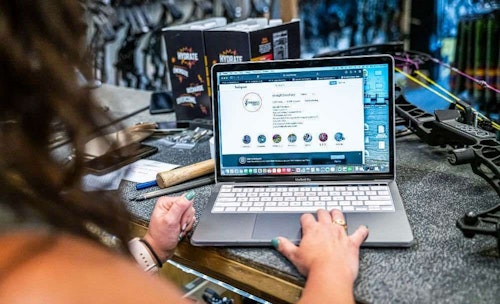
Have dedicated personnel ready to handle walk-in customers who need quick turnarounds on their equipment.
Each year, archery retailers are faced with challenges both new and old. But many of these challenges are self-imposed, or at least, could be self-reduced. There are always hard and easy ways to do things. Here are 15 tips to help shop owners, managers and employees work smarter instead of harder during the busy season this year.
1. Gauge the Demand Forecast
Understanding what the busy season might look like, and forecasting demand, is a crucial element in preparation to work smarter during the busy season. Gauging the demand, and adjusting your supply accordingly, is an important step in hitting projections.
Obviously, it’s crucial to not overestimate product sales and sit on too much inventory. But you don’t want to understock what are likely to be popular items, either. Getting as close as possible to the forecasted demand is the goal.
Drilling down, the most important factors for demand forecasting include anticipating potential purchase trends, readying inventory levels (in relation to typical demand), maximizing stock levels, knowing order placement lead times, and planning potential reorders.
2. Moderate Marketing Efforts
Marketing should precede virtually all busy-season pushes. While it might sound counterintuitive, marketing well before the busy season helps you meet the demand once it arrives.
For example, marketing early helps gauge the demand of specific products, and the general state of the market. That makes pre-busy-season preparation easier and more accurate.
Additionally, it can spread out the inflow of customers, rather than packing in more customers into a shorter span. This spreads out the selling season for each individual product, effectively giving you more time to provide customers with the products and services they want.
Next, it increases time to sort through supply chain issues, which really began rearing their ugly heads in 2020. It also alleviates pressure on suppliers, and allows you time to find new suppliers, if needed. You might even negotiate lower costs, and lower shipping prices, by ordering ahead of other businesses.
3. Stay in Contact With Customers
Use all available means of communication with your customer base. Websites, social media channels, email marketing, and other methods, are key components for staying in contact with customers. Top-notch communication virtually always improves relationships.
“Sometimes, even knowing what products exactly the factories have ready to ship day by day is helpful,” said Logan Beach of Mammoth Outdoors in Bowling Green, Kentucky. “Social media is the clear leader in technology with just about every person and company tuning in daily to see what is the next best thing. This helps shops promote quickly and to a much wider audience, rather than just their immediate town. It is also a great way to build a following and help spread the word of archery and the outdoors to eyes and ears of people who may have never experienced it.”
4. Optimize Inventory Accuracy and Efficiency
Another important aspect is optimizing inventory accuracy and efficiency. Implementing programs and software to ensure accurate inventory counts throughout the year makes stocking, selling, and re-stocking much more efficient.
“Cellphones and the use of order writers make getting products much simpler,” Beach said. “The days of flipping through a 400-page book looking for your item number are nearly behind us. With a simple text or email, you can have product on the way.”
5. Get the Team Ready
Preparing yourself and the entire team is an important step in working smarter throughout the busy season. Train yourself and your staff in key categories, including order management systems, point of sale systems, general best practices and internal methods of operation.
Of course, training should begin as soon as possible. Educating the team on key products will create a smoother busy season, too. Each staff member maintaining a firm understanding of moderate- to top-selling products ensures swifter and more accurate communication with customers and won’t require additional employees to answer important product questions.
Furthermore, help each employee understand how to pitch a product accurately and efficiently. This fast delivery gives the customer everything they need without unnecessarily long discussions. Furthermore, working with pre-prepared marketing materials aids in that effort, too.
6. Consider Your Pricing
Pricing is another significant factor in busy-season success. One example is implementing dynamic pricing, which is a practice most businesses should consider. This is a system where prices fluctuate based on supply and demand, which can alleviate some pressure during the busiest times of the year.
For example, if prices rise, and volume declines, you can still make the same or more profit just from having higher pricing. Of course, you still must maintain an understanding of competitor pricing, the market demand, and other key factors, in relation to your own inventory and pricing.
7. Maintain Inventory Levels
Keeping track of inventory levels is crucial throughout the year, but especially during busiest times. Maintaining inventory at healthy levels ensures there is plenty of product for customers, which improves customer satisfaction, employee morale, and boosts bottom lines. Everything runs much smoother, and working harder isn’t as necessary, when everyone works smarter.
Similarly, maintaining contact with archery suppliers is another significant component of a well-designed busy season game plan. Doing this helps keep open lines of communication with the very suppliers who can impact your inventory.
8. Use Available Technology
Without question, technology has helped make life easier for archery shop owners, managers, employees, and customers. “Technology helps with inventory control, ordering, as well as product promotion via social media,” Beach said. “Being able to quickly adjust and view inventory helps keep products in check and a close eye on what products are selling fast and what is taking place.”

9. Check Key Systems Before the Big Push
All-important systems should be checked and ready to go for the big push. Ensure each integral program, software, and other tools are ready to go before the busy season begins. This works out potential issues long before the busiest times arrive, and streamlines things once they do.
For example, order management systems and point of sale methods should be checked and double-checked before the big push begins. Additionally, deploying a mobile-friendly website, and streamlining as much as possible, will boost sales with fewer needed man hours.
10. Integrate Brick-and-Mortar and Online Stores
Most modern businesses have both brick-and-mortar and online stores. The days of these operating independently are over. Instead, these must be integrated and run in conjunction with one another. This is essential for maintaining accurate inventory and making the busy season as successful as possible.
11. Have Dedicated Walk-In Assistance
While not every archery shop can afford adding to its existing staff, some can. Those with the ability to do so should benefit from dedicated walk-in assistance.
“Always have at least one person available for walk-ins or quick fixes,” Beach said. “Occasionally, it’ll be busy, and it just can’t happen. But being able to do smaller tasks right then can be extremely beneficial to the workflow.
“For example, if someone comes in and needs a D loop tied on, that is something that can be done in 5 minutes or less — instead of having them leave their bow with you and picking it up another day. Knocking out D loop installations, tying in peeps, and a few other smaller things can help keep down the clutter of work to be done throughout your work week.”
12. Speed Up Checkout
Businesses with systems in place that speed up checkout almost always handle the busy season in a better manner. It frees up owners, managers, and other employees to complete additional tasks, rather than getting swamped with fewer interactions.
In addition to reducing employee time spent on each transaction, fast checkout is necessary for retaining long-term customers. Research studies have proven that avoiding long checkout lines and wait times improves customer satisfaction and loyalty. That’s important.
All said, faster checkout systems and multiple checkout locations helps to improve times across the board. That’s a win for the business and the customer.
13. Group Similar Tasks Together
Some believe multi-tasking is the way to go. Research has proven multi-tasking isn’t as productive as once believed. “Knocking out work that is the same helps keep a good rhythm,” Beach said. “A lot of times when it gets down to crunch time, the demand for quick turnaround increases drastically. Being able to get in a rhythm and stay in one while doing work makes it a bit easier. You’ll be quicker and more efficient because you’re in a routine with the same steps over and over.
“Whether it’s string swaps or fletching arrows, I try to pick days and do them all that day. It also helps when people begin picking up their orders. The process is the same and much faster giving you more time to get the next run of folks up and going.”
14. Educate Customers on Best Practices
During the busiest times of the year, employees might not have as much time on repairs. Rather, their time is best spent on new sales and setups. Therefore, benefit your customers and the shop itself by educating customers on best gear practices.
“Swapping your strings routinely and the proper storage of your bow are important,” Beach said. “Having good quality strings will save you a lot of headache when dealing with your bow. If you keep them well maintained, you can avoid problems such as losing poundage, your cam sync being out of time, and peep twist.
“Any of those things can be detrimental to your hunt and experience if gone untouched. Shockingly, most people hadn’t put much thought into proper storage before the last few years. Leaving your bow in your truck or hanging it in the garage with temperatures fluctuating constantly can cause many issues. Breaking down your string fibers as well as exposing some of the plastic products to the elements can deteriorate them over time. Storing your bow inside in a case is always recommended during the off-season or during longer stints in-season.”
15. Stay on Schedule
Staying on schedule is part of prepping for the busy season. Getting behind happens, but a well-tuned game plan makes it easier to tackle even a long-term busy season. If you anticipate being overwhelmed by demand, and don’t have the internal manpower to keep up, consider a fulfillment company. This can help alleviate some pressure with order shipping. This reduces overall profit, but think of it as profit you wouldn’t achieve anyway without the additional aid. After all, maintaining satisfied customers is the goal.
Sidebar: Reward Your Customer Base
Customers are the lifeblood of any retail business. There are several important things to remember when maintaining the loyalty of a customer base. Showing them you care, and not treating them like just another retail transaction, is important for your dignity and humanity, let alone the longevity of your business.
First, talk to customers, especially those seeking a conversation. It’s your job to help them, answer questions, and make them feel welcomed. Treat them with utmost respect, and be a resource (if they’re seeking one).
Additionally, offer an inexpensive refreshment. A cup of water or bag of popcorn goes a long way. Odds are good they’ll return if you offer them some small token of appreciation.
Likewise, providing a good waiting and entertainment area can do the same. Those who are waiting in line to have their bow worked on, or to be seen about a new purchase, should have an area where they can patiently wait. Maybe that’s a couch with a television displaying hunting-based programming. Perhaps it’s a wall with interesting or entertaining infographics that enlighten and entertain. Regardless, make the wait easier for the customer, and they’re more likely to wait, and even return.
Of course, it goes without stating, but be honest with customers about availability, timelines, etc. Don’t drag them on if you’re unlikely to deliver. If waiting is a must, give customers regular updates. Additionally, consider offering the option to move to the front of the line (for a fee) to those who truly need a very fast turnaround.
Do these things, and incorporate your own methods for rewarding loyal customers, and this busy season should be a positive one.
Photos by John Hafner






